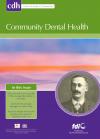Community Dental Health

- Cover Date:
- December 2008
- Print ISSN:
- 0265 539X
- Vol:
- 25
- Issue:
- 4
The frequency of periodontal infrabony defects on panoramic radiographs of an adult population seeking dental care
By means of panoramic radiography (PR), the frequency and location of interproximal infrabony defects (IPIDs), their relationship with age, gender and remaining teeth were studied in 416 individuals seeking dental care. The presence/absence of IPIDs and the defect depths were evaluated on mesial and distal surfaces of a total of 8,964 teeth. One or more infrabony defects were recorded on 23% of the PRs (96 individuals, 152 IPIDs). The frequency of infrabony defects ≤ 3 mm, 3-5 mm and ≥5 mm was 12.5%, 9.6% and 3.6% respectively. The number of infrabony defects ≥ 5 mm was significantly lower than infrabony defects in ≤3 mm and 3-5 mm groups (p<0.05). The difference between the frequency of IPIDs among two genders was non-significant (20.6% for females, 26.8% for males). The IPIDs were most prevalent in the oldest group (>50 years), which also presented with significantly more missing teeth (p<0.05). The most frequent locations for IPIDs were maxillary and mandibulary molar teeth.
Key words: dental radiology, interproximal infrabony defects, linear measurements, periodontology
Introduction
The essential characteristic of destructive periodontal disease is the loss of tooth-supporting alveolar bone. In general, horizontal bone loss is differentiated from vertical bone loss, which is termed as an infrabony defect since the bottom is apical to the alveolar crest. The presence of infrabony defects complicates marginal periodontitis and influences therapy and prognosis (Weinberg and Eskow, 2000). The treatment methods for infrabony defects have been evaluated in several studies; however the current information on their prevalence and location in human adult populations is limited (Camargo et al., 2002, Francetti et al., 2004). Although early radiographic studies have indicated the presence of severe periodontal diseases in adult age groups (Marshall-Day et al., 1955), recent studies in industrialized countries have reported that advanced bone loss is uncommon under the age of 35 and infrabony pockets and furcation lesions are seldom found in subjects under 40 (Müller and Ulbrich, 2005). A number of studies have been carried out to determine the prevalence and distribution of periodontal conditions among different European and Asian populations (Baelum et al., 1997, Müller and Ulbrich, 2005, Müller et al., 2005). However, there have been no reported national or regional surveys of the prevalence of periodontal interproximal infrabony defects in an adult Turkish population. Therefore, the purpose of this study was to determine the frequency and location of interproximal infrabony defects (IPIDs) recorded from panoramic radiographs (PRs) of adult patients sampled at the radiological archive of Ege University, School of Dentistry. The influence of
age, gender and remaining teeth on the presence of IPIDs was also investigated.
Methods
The panoramic radiographs (PRs) of patients 20 years and older were drawn at random from the records of the University of Ege, School of Dentistry, Department of Oral Diagnosis and Radiology between December 2004 and December 2005 (12 months). The selection of PRs was performed by drawing lots for each month using patient record numbers and aiming to pick 50 PRs per month. Radiographs with sufficient contrast/brightness and no significant distortions/projection errors were selected by one of the authors (BIK). PRs were obtained using Ortopantomograph OP-100 Palomex (OY-Finland & Siemens Corp-West Germany) and the films were developed in an automatic film processor (Dürr-Dental, Bietigheim, Germany). After digitization with a flatbed scanner at 600 dpi (Hewlett Packard Scanjet XPA 7400c), images were saved as TIFF files and transferred into a software (UTHSCSA Image Tool Version 3.0, San Antonio, Texas). The viewing sessions were performed in a darkened room to minimize glare with the images displayed on a 17 inch monitor (Philips Electronics, Koninklijke, Netherlands). The presence or absence of IPIDs and the depth of defects were evaluated on mesial and distal tooth surfaces (3rd molars excluded) on each image by two specialists in Oral Diagnosis and Radiology Department. (R1 and R2) The linear measurements of the IPIDs were performed between cemento-enamel junction (CEJ) and the most apical extension of the bony defect (BD). If the CEJ
Correspondence to: Professor Nesrin Dundar, Ege University Faculty of Dentistry, Dept. of Oral Diagnosis and Oral Radiology, 35100, Bornova, Izmir, Turkey. E-mail: nesrinergul@yahoo.com
- Article Price
- £15.00
- Institution Article Price
- £
- Page Start
- 226
- Page End
- 230
- Authors
- N. Dundar, T. Ilgenli, B. Ilhan Kal, H. Boyacioglu
Articles from this issue
- Title
- Pg. Start
- Pg. End
- Effect of tooth loss and denture status on oral health-related quality of life of older individuals from Sri Lanka
- 196
- 200
- The distribution of general dental practitioners with NHS contract numbers in relation to the distance of their practices from the seven dental undergraduate teaching hospitals in England outside London
- 201
- 204
- Australian Research Centre for Population Oral Health, The University of Adelaide, Australia
- 205
- 210
- The frequency of periodontal infrabony defects on panoramic radiographs of an adult population seeking dental care
- 226
- 230
- Caries prevalence and need for dental care in 13–18-year-olds in the Municipality of Milan, Italy.
- 237
- 242
- Access to dental services for people with a physical disability: a survey of general dental practitioners in Leicestershire, UK
- 248
- 252
